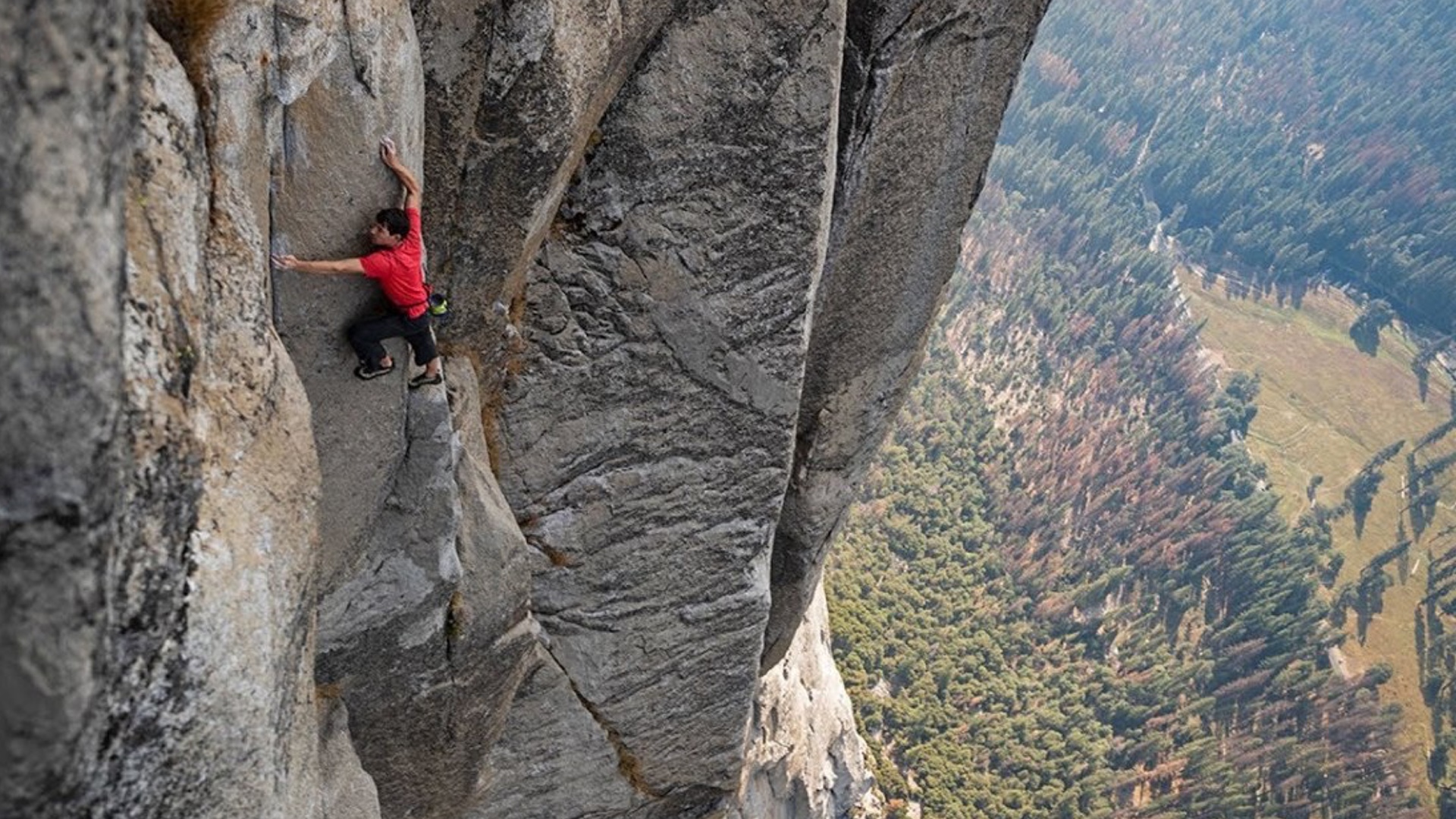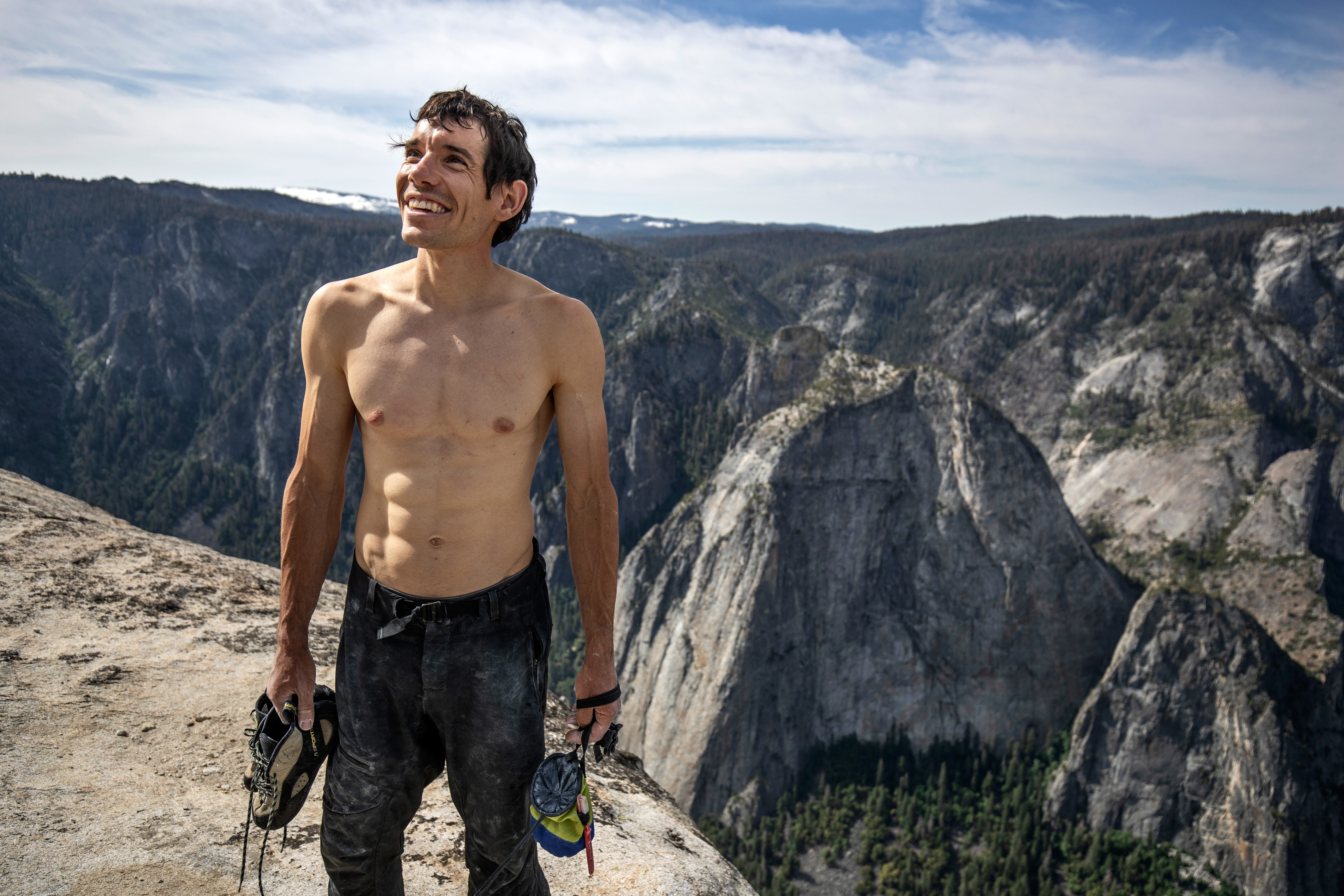
(Photo: Jimmy Chin/National Geographic)
In many ways, Alex Honnold is an unlikely hero. The star of the hit film Free Solo, which just won the Academy Award for Best Documentary, was an outcast as a kid and says that a “bottomless pit of self-loathing” is what pushed him to seek epic achievements. As an adult he still isn’t much for relationships. “I will always choose climbing over a lady,” he tells an interviewer in the film.
Looked at another way, he’s the most predictable hero of all time.
Since Ernest Shackleton forged a path toward the South Pole, Edmund Hillary and Tenzing Norgay climbed Mount Everest, and Neil Armstrong touched down on the moon, men who test themselves against nature have represented the normative measure of heroism in the modern West. It’s telling that the era when Shackleton set sail was known as the Heroic Age of Antarctic Exploration—an age that soon gave way to the only slightly less manly Mechanical Age of Exploration.
No wonder it’s become accepted wisdom that man’s relationship to nature is primarily an oppositional one of “man vs. nature” (and the conceit of bold opposition, historically speaking, would certainly seem to skew male). It’s in the history books with Columbus “discovering” America, and there again several hundred years later when Lewis and Clark went Columbusing through the west. This rugged sense of the hero’s journey dates at least as far back as Greek epic, where Homer’s Odysseus, barred from returning home after angering the sea god Poseidon, embarks on a quest to experience, and defeat, all manner of creatures and elements.
But in 2019, with the planet poised on the brink of environmental calamity—one due, more or less, to man’s having already conquered everything—the “man vs. nature” mythos is in need of some revision.
For years, scientists have been saying that pure “nature” untouched by humans is almost entirely gone. “People have been modifying their environments for tens of thousands of years,” Jon Erlandson, the director of the University of Oregon’s Museum of Natural and Cultural History, told the Washington Post in 2016. “Humans have literally impacted everything from mammoths to microbes.”
Recently, though, our impacts on the natural environment have accelerated.
In the 60-plus years since men first summited Everest, for instance, the world’s tallest mountain has become ground zero for wealthy clients paying many tens of thousands of dollars to test their mettle against the mountain, and its once-pristine face of snow, limestone, and marble has become littered with discarded camping gear and human excrement.
And Everest is about as remote as it gets.
We are living in what scientists call the Anthropocene, or “age of humans,” when mankind isn’t subject to the natural landscape so much as constantly shaping it—and, by extension, our future.

(Photo: Jimmy Chin/National Geographic)
“The idea of ‘nature’ went out with the 20th century,” Jedediah Purdy, a professor at Columbia Law School and author of the book After Nature: A Politics for the Anthropocene, wrote in Dissent last year.
Part of the reason for that, Purdy explains, is strictly physical: It’s more difficult in the modern era to distinguish between natural and non-natural landscapes. After all, the detritus of human life can be found nearly everywhere, from trash islands in the Pacific to the radioactive Plutonium that’s still present in the upper atmosphere from nuclear weapons testing half a century ago.
Another reason is a growing recognition that nature and how we relate to it are now always political, shaped by imperialism, capitalism, and the stories we tell about the natural world.
As Purdy writes: “The human species is remaking the planet as an integrated piece of global infrastructure—in its artificial carbon and nitrogen cycles, climatic patterns, energy flows, biodiversity, and its skin of roads, farmland, and settlements. What, then, of the further question, ‘What sort of world shall we make?'”
Like it or not, we’ve already altered nature, and are presently less its adversary or victim than its careless custodian. Given this evolution in our relationship with the Earth, it’s time we altered our heroic narratives as well.
The truth is this: Humans are afflicted in the wild only if disaster strikes or we’ve made ourselves artificially vulnerable by embracing the most dangerous thing. That’s why Honnold climbed El Capitan (known affectionately as “El Cap”) without a rope, an approach that’s controversial even within the climbing community: to give the illusion of a fair fight.
But the operative question in the Anthropocene isn’t whether men who pick their perils will survive. It’s whether the planet and everyone else will.
Honnold is the latest in a cultural succession of adventurers; a bullfighter, here to wow and entertain with carefully calculated daring—and everyone knows that, even when the bull wins, it doesn’t.
Honnold isn’t a household name because he’s the best rock climber out there. (Adam Ondra is arguably the best sport climber.) And his route up El Cap wasn’t even the most challenging on the mountain, let alone in the world. Rather, Honnold has come to fame because he has taken the biggest risks. But in the name of what, exactly? So that audiences can hold their collective breath and wait for him to fall? What is it about his willingness to risk his life while his girlfriend waits in a van to find out if he’s dead or alive that makes him so admirable—a mountain hero, as so many would have us believe?
GQ hailed him as a “Rock God,” and Esquire called him “The Most Self-Reliant Man on Earth.”
But there’s such a thing as taking self-reliance too far. Just ask Christopher McCandless, or Henry Worsley, or Timothy Treadwell. Oh wait, you can’t.
A worthier kind of hero might see where the real battle lines are drawn: not up the face of El Cap, but in the surrounding forests of Yosemite National Park, which was forced to close after large swaths of it were ravaged by fire last year during some of the most destructive wildfires to occur in California’s history. These extreme weather events are thought to be occurring because, well, man has already conquered everything.
A worthier kind of hero might see beyond the park, as well, to consider a state that’s up in smoke and sliding into the sea, in a country deaf to our own calamity and to the greater ones facing others around the world.
Here, at least, Honnold is ahead of his fans. When a fawning National Geographic interviewer asked him last year whether he has “any notion of how big a deal this is” and whether he thinks “the world kind of needed something cool like this, at this moment in time,” Honnold offered a reality check.
“What the world needs is for the U.S. to stay in the Paris Accords. There’s some bigger issues,” he replied. (Honnold works on some of these “bigger issues” through the Honnold Foundation, a charity that helps reduce environmental impacts and support solar energy initiatives around the world.)
And yes, even the simple act of drawing public attention to the wonders of the natural world—as Honnold does through his climbing—is arguably a form of advocacy. Travel experts are already predicting a spike in visitors to Yosemite this year as a result of the publicity Honnold has drummed up.
But the Honnold myth has grown bigger than any ideals he might personally hold. And his encouragements to those who would take inspiration from his free-handed climbs as a way to conquer fear, or conquer something, make him complicit in a narrative that’s wrongheaded and outdated. In 2019, we have better tools for conquering our private fears (here’s a hint: it starts with understanding and naming them, not pretending you don’t need anything because you’re manly).
Free Solo pays passing attention to larger questions, like what drove Honnold to the rock face, but it never seeks to resolve or contextualize them. We learn, for instance, that owing to irregularities in Honnold’s amygdala, he doesn’t register fear like other people, and the film suggests that these irregularities are likely what keeps him from being paralyzed mid-climb, as someone with a more ordinary fear make-up very likely would be.
Honnold seeks to inspire viewers with his fear-conquering free solos, and he’s fast becoming a self-help poster boy for overcoming fear, but the movie’s look into the structure of his brain reveals a problem with that inspirational formula: Honnold isn’t afraid of heights, not like most of us anyway. Whatever else is going on in his heart (the movie suggests struggles around intimacy), in climbing El Cap, he’s facing down what’s hard for us, not what’s hard for him.
The film treats Honnold’s quite-literal fearlessness as an aberration, the thing that makes him vulnerable and different—and perhaps that’s true with respect to more ordinary people. But fearlessness is a central component of what we’ve been taught to worship in our manly heroes, as well as in our supposed best selves; it’s just that Julius Caesar didn’t describe it using a brain scan and neuroscience terms.
Exhortations to fearlessness are everywhere in our culture, and Honnold himself seems, at times, to embrace them, referring to himself here and there as a “warrior” and “gladiator,” even as he pokes fun at himself for using these words.
There’s a place for the fearless brand of bravery—when faced with how to handle an active shooter, say. But, for instance, the Indiana school teacher who tackled and disarmed a guy gunning down kids in his 7th-grade classroom is not a hero because he wasn’t afraid. He’s a hero because he recognized in a flash that it was worth risking everything to stop what was unfolding. That’s meaningful bravery: saving a life, not needlessly endangering your own.
Climbing a big rock doesn’t clear that bar. Nor does the fact that Honnold didn’t fall absolve his crew from filming, or audiences from gawking, or the Academy from slapping its highest honor on the back of an endeavor that teaches young people the dubious lesson that self-mastery looks like a guy dangling himself off the highest natural precipice he can find. (The link between courting transcendentalism and death has never seemed more clear.)
Of course Free Solo‘s just the tip of the iceberg for this genre of self-seeking heroics. But as a species, we’re too old to keep doing this—for our own sakes and the planet’s.
As the climber Chris Kalman wrote back in 2017, Honnold is clearly a “truly exceptional human being,” but Kalman also expressed hope that the famous climber might one day be remembered for something greater than free-soloing El Cap.
“Maybe it will be his humanitarian work,” Kalman wrote. “Maybe it will be knowing when to quit—something so many of his predecessors didn’t seem to figure out.”
Meanwhile, perhaps the kindest thing we can do now is look away.

Pacific Standard’s Ideas section is your destination for idea-driven features, voracious culture coverage, sharp opinion, and enlightening conversation. Help us shape our ongoing coverage by responding to a short reader survey.





